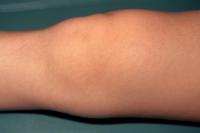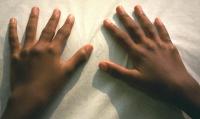| |

- Arthritis is the general term that refers to inflammation within a joint. When a joint develops arthritis, it becomes hot, swollen and painful. The joints allow smooth motion between adjacent bones. All joints have a lining of tissue called synovium. This synovium secretes a special fluid called synovial fluid. In healthy joints the synovial fluid lubricates the joint, allowing it to move easily. Synovial fluid works the same way as the motor oil does in a car engine. It allows all of the internal parts to move freely and easily without sticking against one another (9).
- When a joint develops arthritis, the synovium becomes swollen and big in a process called synovitis. The inflamed synovium produces too much synovial fluid and this result in swelling (14). Cells that respond to inflammation build up in the joint fluid and releases substances that may destroy joint tissues. Instead of being a lubricating fluid , like oil, this joint fluid is more like water. Imagine what would happen if you put water in your car engine instead of oil. With this comparison, the abnormal synovial fluid causes the joint to become stiff, hard to move and hurt.

Signs and Symptoms of Juvenile Rheumatoid Arthritis
- Fatigue is a common symptom in children with JRA. Fatigue may be expressed as increased sleep requirement, lack of energy or increased irritability. Night pain may interrupt sleep and so contribute to fatigue. Anorexia, weight loss, and growth failure maybe observed in many children, especially those with systemic JRA.
- The arthritic joint exhibits the cardinal signs of inflammation that includes swelling, heat pain and loss of function.
- The child with JRA may not complain of pain at rest, but active motion can start the pain. Pain is usually described as aching or stretching and is of mild to moderate severity. The manner in which a child communicates discomfort varies according to age. In a young child, there may be no complaints of pain, although it is not clear that the child is actually not experiencing pain. Young children may, however, adjust the manner of use of the affected joint in order to avoid pain up to refusal to use the affected joint entirely. In these observed situations, the parents may report that the child does not appear to be in pain but he or she limps while moving. It is hard to use a joint that hurts. Like mentioned, if the arthritis is in a leg joint, the child may limp. If the arthritis is in an arm joint, the child may have trouble writing, dressing or performing other activities.
- Arthritis affects the extremity such as arm, leg, and fingers in several ways. Any joint can be affected by JRA, but large joints are most frequently involved. Small joints of the hands and feet may also be affected particularly in polyarticular type of JRA. Arthritis makes the joints difficult to move. As a result, the joints often become fixed in a bent position called contracture (14).
- All of the abnormal movement will cause the the muscles that normally support the joint to become weak. Severe arthritis that lasts for a long time can damage the joint surface making it rough instead of smooth. This process is called joint erosion. Arthritis is treated with a combination of medications and exercise. Medicines reduce inflammation and exercises preserve the normal motion of the joint and muscle strength.
 
HOME
|